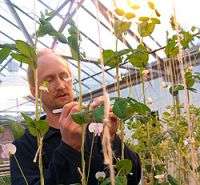Discovery may allow plant breeders to 'switch off' flower production

(Phys.org) -- A research project has discovered a new gene with an important role in generating flower-bearing structures (inflorescences) in plants.
The research will be published in the online journal Nature Communications.
Dr Jim Weller, from the UTAS School of Plant Science, worked on the project with colleagues in Spain and the UK.
“This work investigates how the arrangement of flowers on a plant is controlled, and focuses on legumes, an important group of crop plants that includes peas, lentils, beans and chickpeas,” Dr Weller explained.
“Plant inflorescences can range from simple (such as a tulip or poppy) with a single stalk and a single flower, to more complex, with multiple branches and numerous flowers (such as tomatoes, cereals and legumes).
“Identification of genes that control these differences gives us insight into how they might have evolved.
“In this case we identified a gene called VEGETATIVE1, which controls an important step in legume inflorescence formation,” Dr Weller said.
“This work also offers prospects for breeding of legume crops. For example, yield and harvest efficiency could be improved by developing new varieties with different inflorescence structures.
“It may also be possible to switch off flower production, which could be desirable in crops grown for animal fodder such as lucerne.”
Dr Weller said the UTAS contribution included detailed genetic and gene expression work by PhD student Frances Sussmilch and postdoctoral research associate Dr Valérie Hecht, and relied heavily on use of the School of Plant Science’s Controlled Environment Facility for plant growth.
Provided by University of Tasmania

















